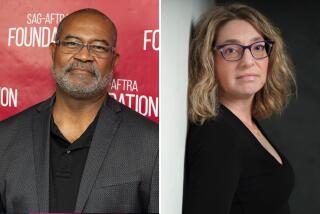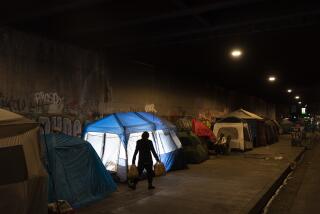Red Sunlight Through Ragged Palms
Few sequences in modern crime fiction are as breathtaking and poignant as the final moments of Walter Mosley’s 1996 novel, “A Little Yellow Dog,” when Mosley’s hero, Easy Rawlins, and Raymond “Mouse” Alexander, his partner of some 20 years, are ambushed in a blind alley in South-Central Los Angeles. With a few deft strokes, Mosley brings the world to its knees.
It’s 1963. JFK’s just been assassinated, Los Angeles has come of age and, in a hail of gunfire, Easy and Mouse find themselves fighting for their lives. It’s a familiar moment, only this time everything goes wrong. Mouse gets hit, and in their escape, Easy watches his best friend slip away. Is it any wonder Mosley took six years--and six other novels--before telling us what happens next? Some things you just don’t walk away from.
The much-anticipated sequel to “Yellow Dog” and the latest in his bestselling series of Easy Rawlins novels, “Bad Boy Brawly Brown” opens less than a year later. Little has changed in Easy’s life. He’s still holding onto his house in West L.A. and his job as custodian at the junior high. His girlfriend, Bonnie Shay, has moved in. The kids, Feather and Jesus, are there, as well as that mean yellow mongrel he took in a year ago. It’s a domestic scene that Mosley works to perfection, but something’s not quite right.
Early one morning, Mosley catches Easy looking out the living room window. “Red sunlight glinted through the ragged palms at the end of our block. I had never wept over Raymond’s demise, but that tattered light reflected a pain deep in my mind.” Fewer words have ever said more.
Easy’s a haunted man, and Mosley plays it just right, letting the pain stay, then drift aside, so that when the phone rings--a friend asking Easy to help look for his girl’s son, a young man by the name of Brawly--the world effortlessly opens up. Let James Ellroy, Robert Crais and other urban crime writers grab their characters by the throat. Mosley succeeds with finesse.
Brawly’s in trouble, but then he always has been: from the time his parents broke up when he was a child to when his mother had her nervous breakdown; from the time his father started beating him to when his cousin seduced him. And now he’s hooked up with a black radical group, the First Men. Their goal is unclear. The police think it’s violent unrest and vow to smash them. The First Men claim it’s education. The truth probably lies somewhere between the group’s manifesto, which calls for a school and a community center, and a cache of weapons, stored under Brawly’s bed.
It’s a classic formula: the troubled detective called upon for a favor that he has reservations about. “You know yourself it’s better not even to look for’im,” Easy warns Brawly’s stepfather, the man who placed the call. “Either he’s gonna outgrow it or it’s gonna row him under. That’s the way it is for all young black men.”
As always, though, the case gets under his skin. Searching for Brawly soon becomes a balm to his own grief, and before Easy knows it, there’s no backing out. Juggling his relationship with his family, drifting in and out of their lives with some success and some difficulty, he discovers something at stake in finding this young man, something he’s not immediately sure of.
The formula ends here, broken by Easy himself, a man whose intelligence, contradictions and raw sensuality can’t be predicted, a man who perfectly serves Mosley’s ambition to create an ongoing picture of the black community in Los Angeles during the postwar years. We’ve come a long way from Houston, where Easy and Mouse started running together in the late ‘30s, and from Central Avenue in 1948, where Mosley set his debut, “Devil in a Blue Dress.” The streets are angrier and the expectations more pronounced. Just months earlier, three civil rights workers were murdered in Mississippi; a year before, Birmingham exploded.
Only Mosley’s game isn’t to capture the fire, at least not yet. His is a more complicated and nuanced story of black men and women coming to grips with what they want, with what they deserve and how much they can put up with. The volatile years of the civil rights movement are merely a backdrop to a struggle between the pragmatism of an older generation and the restless impatience of its children.
“Older black folks is just scared’a what groups like the First Men stand for,” Brawly’s girlfriend defiantly tells Easy. “They’re scared to stand up and demand what the white man owes them. They just don’t understand that the only way to get somethin’ is to fight for it.”
At 44, nearly twice the age of Brawly, Easy sees it from both sides. Los Angeles--for its racist edge--is nothing compared with where he grew up in Texas where “any poor black child ... was lucky if he lived to make it to bed that night.” But Easy knows just getting through a day isn’t enough. As one of the leaders of the First Men, Xavier Bodan, says, “If we don’t do anything ... then the world will pass black people by. We’ll still be takin’ the bus while other people will be takin’ rockets to the moon.”
We have no reason to dispute him. Early on, Easy’s search for Brawly takes him to a meeting of the First Men, where he sees men and women trying “to create freedom out of the sow’s ear called America. They believed in the spirit of the Constitution and not the direction of the cash register.” But that’s just moments before the police crash the door and prove themselves the greater threat to the republic, masking racist motives with words of patriotism.
Easy, however, has learned the hard way that nothing is certain except killing and death. It’s one reason he finds solace in the memory of Mouse, who visits his dreams and tells him where to stand, but that’s as far as it goes: Easy’s triumph in “Brawly Brown”--Mosley’s too--is being able to solve the puzzle without Mouse at his side. By the end, he realizes that saving Brawly means saving himself and easing the burden he’s carried since the opening of the story, unable to grieve, unable to redeem himself for leading his friend into that ambush.
As in his earlier books, Mosley never takes us far from the need, the vulnerability, the fear and rage of black men in this country, and it is the rage that has a strangely compelling vitality in “Brawly Brown.” The radicalism of the First Men has to be seen as a measure of hope--hope that the world isn’t beyond change--but Easy draws the line.
“Brawly came from a very different generation than mine,” he eventually realizes. “He was intelligent and ambitious where I had been crafty and happy if I made it through the day. I never questioned the white man’s authority--that was a given.
“But what really separated us was a need for love and his trust in people. He believed that there was a place for him and his in the world. I knew ... that the only way to truly save him was to shatter this belief.”
It’s a brilliant solution, no matter the cost, but by courting disillusionment, Mosley passes a judgment of sorts on adventurism: that political action--violent or pacific--doesn’t affect anything. Worse still, because it is grounded in hope, it is largely irrelevant and doomed. It’s a debatable issue: In the end does “Brawly Brown” close on a note of resignation or reality?
The answer isn’t forthcoming, but what is clear is that only grief--and love--can change a man. All else is window dressing. As Easy says, “I’m just a everyday black man, doin’ the best I can in a world where the white man’s de facto king. I got me a house with a tree growin’ in the front yard. It’s my tree, I could cut it down if I wanted to but even still you cain’t call it a black man’s tree. It’s just a pine.”
It is a comment that speaks not only for the place and the time that Mosley has so effortlessly captured but also for the succeeding years when racism--the underlying momentum of these novels--became less institutionalized and problems once rooted in black and white realities became more deeply ingrained in hard economic truths.
With “Big Bad Brawly Brown,” a story with the same imaginative vigor and the same unflinching honesty as its predecessors, Mosley continues to put a strong claim on urban crime fiction, a claim that says as much about the city of Los Angeles as it does about America at large. In his success, he once again leaves us eager for more. The Watts riots and the succeeding years of neglect and disregard in South-Central loom ahead in the dark and violent life of Ezekiel Porterhouse Rawlins.
More to Read
Sign up for our Book Club newsletter
Get the latest news, events and more from the Los Angeles Times Book Club, and help us get L.A. reading and talking.
You may occasionally receive promotional content from the Los Angeles Times.







